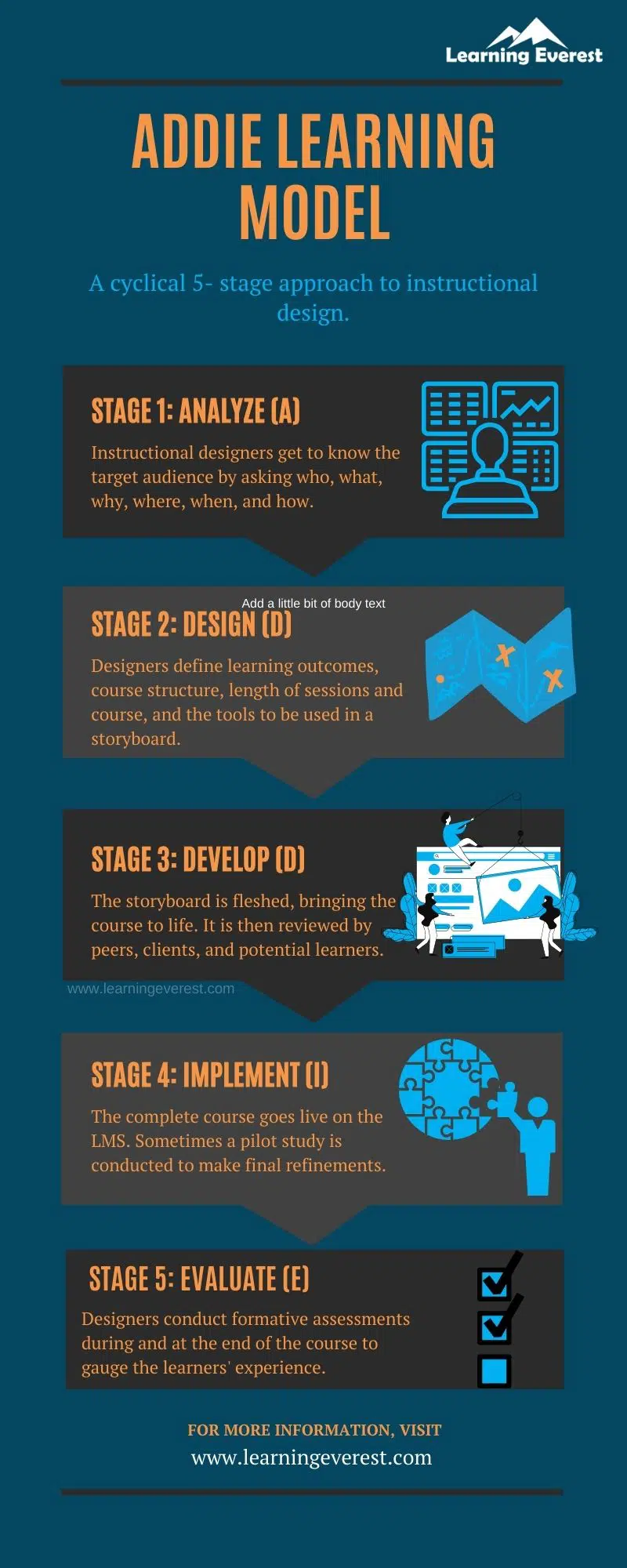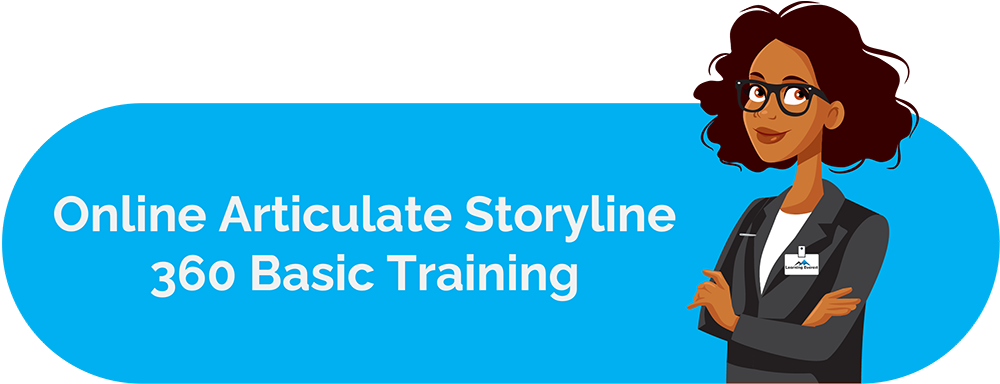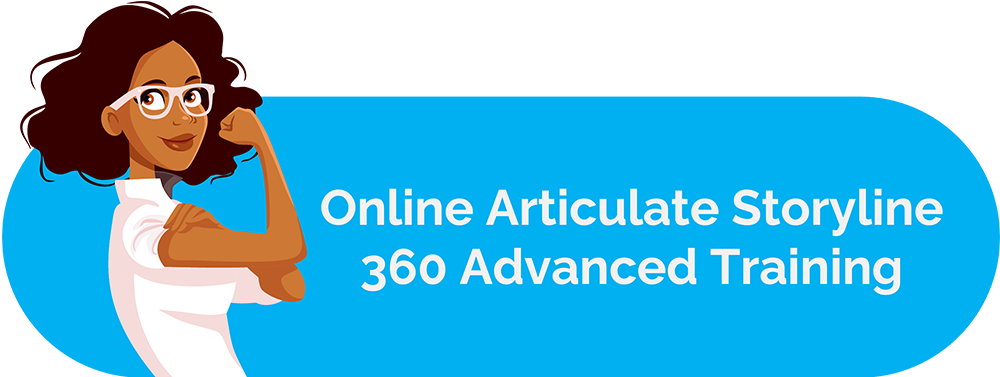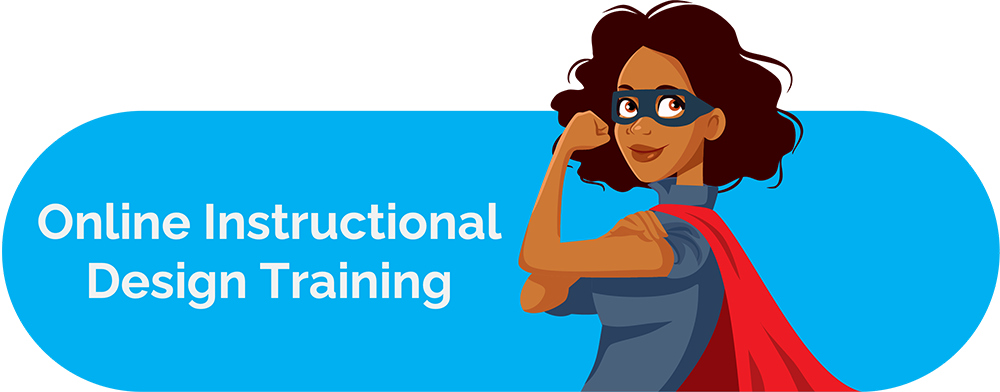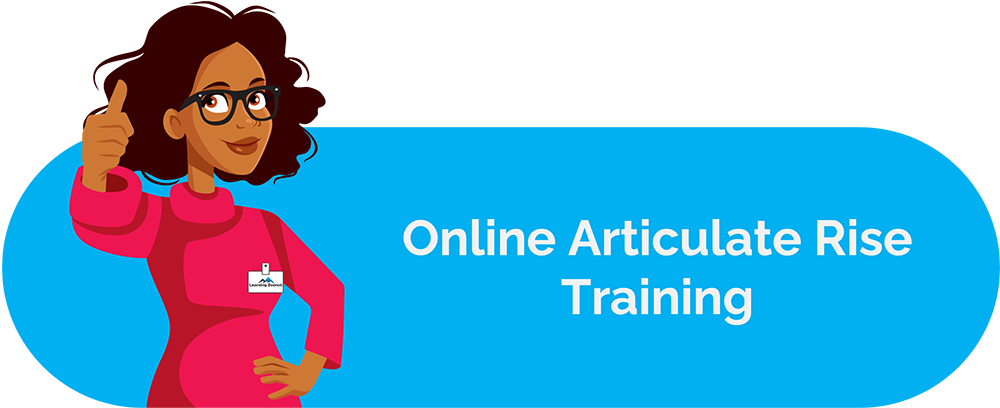The ADDIE learning model is a course designing model instructional designers use to make efficient and engaging courses. First developed at Florida State University in 1975, the ADDIE learning model has since become the most widely used approach to instructional design. There are 5 stages in this model.
They are as follows:
(A) Analyze
(D) Design
(D) Develop
(I) Implement
(E) Evaluate
This model has effectively stood the test of time due to its simplicity and efficiency. It incorporates all essential steps to creating a good course under one flexible framework. IDs can apply ADDIE to big or small projects.
The Stages of the ADDIE Learning Model
As mentioned above, the ADDIE learning model has 5 distinct stages – Analyze, Design, Develop, Implement, and Evaluate.
The model functions cyclically, where one can go back to previous stages to refine the course and its delivery after the evaluation stage. It’s a model that relies on being systematic and gathering continuous feedback.
Stage 1: Analyze
Before putting a course together, IDs need to understand the target audience, the desired learning outcomes, and how information delivery will occur.
Designers do so by asking who, what, why, where, when, and how.
- Evaluating “who” the learners are includes their age, schooling level, gender, first language, computer literacy, experience and expertise with the subject matter, etc. The process seeks to pin down vital demographic details.
- The “what” revolves around questions like desired learning outcomes, target skillsets to be built, contexts in which learners will apply the knowledge, etc.
- By asking “why” questions, instructional designers typically try to understand the purpose of the course and the value it will add to learners’ existing knowledge and skillset.
- “Where” and “when” help determine the learning environments in which learners will receive instruction. Questions like whether lessons will be virtual or face-to-face, whether class timings will be pre-determined or up to the learner, etc., get answered by asking such questions.
- “How” tackles the delivery format. Such questions pertain to the breakup of syllabi, sequence of modules, whether sessions will be live, pre-recorded, or a blend of both, etc.
- Apart from this, designers look into potential limitations and learning gaps the target audience might have and tailor the content accordingly.
Stage 2: Design
This stage of the ADDIE learning model is where designers use much of their expertise. In the design stage, IDs develop ways to achieve the goals that emerged in the analysis phase.
They clearly define the learning objectives and outcomes, course structure, length of individual sessions and the course, and the L&D strategies to achieve these.
IDs outline classroom activities to facilitate revision and recall, application of concepts, and generalization of skills. They plan strategies to measure student learning and instructor feedback. For this, it is essential to construct good surveys and assessments to gauge the learning experience and outcomes.
Another crucial task in this stage is planning and structuring the content delivery to appeal to users with different learning styles. Thus, incorporating audio, visual, and experiential elements becomes crucial.
The primary outcome of the design stage is a storyboard. Storyboards are brief outlines of a course’s overall structure. They are usually made as slide show presentations listing all the major elements of the final product.
A typical storyboard includes numbered slides, title and content pages, pictures, voiceover script, and navigation buttons.
Stage 3: Develop
After outlining the overall structure, it’s time to develop the course. In the ADDIE learning model, the development stage is where the storyboard’s elements are fleshed out to create a full-fledged consumable product for learners and instructors.
In this stage, the content comes to life. Designers achieve this by:
- Adding graphics and animations
- Using appropriate font styles, sizes, and colors
- Providing video resources
- Developing interactive and engaging activities
- Developing assessments for learners
- Ensuring smooth navigation around the course content from the students’ end
The course is then reviewed by peers, stakeholders, and potential learners for feedback and refined accordingly before the process finally moves to the second last stage of the ADDIE learning model.
Stage 4: Implement
After development and subsequent edits, the course is good to go live. IDs can either upload it to a learning management system and select delivery options right away or conduct a pilot test to figure out any last glitches.
In this stage, the learners, instructors, and learning environments are addressed directly.
Learners receive a preliminary demo of the learning management system they’ll be using. Learning outcomes, course structure, and course contents are explained to instructors to ensure standardized delivery. And all software and infrastructural prerequisites are set up.
Stage 5: Evaluate
The last stage in the ADDIE learning model is the evaluation stage.
Evaluation is of 2 types – formative and summative. Both kinds seek to answer similar questions but occur at different junctions of the course designing and delivery process.
Formative evaluations occur when the course is being designed or delivered. Thus, a formative assessment can occur during the ADDIE learning model’s design, development, and implementation stages. This kind of assessment seeks to solve issues and improve the instructional design in real-time.
Summative evaluations occur once a course has ended. They seek to gauge whether the learners met the learning outcomes and to what extent. Data collected from summative evaluations help design or improve future versions of the training.
Evaluations are done in groups or individually, depending on which is convenient and appropriate.
Some tools used frequently by instructional designers to evaluate a course’s success are:
- Surveys
- Interviews
- Focus groups
- Feedback forms
The benefits of the ADDIE learning model
The ADDIE instructional design model has stood the test of time and stayed relevant for almost four decades. It lends this success to three key strengths:
- Flexible and iterative – though the ADDIE learning model was initially a linear model of designing courses, it evolved to become highly adaptable, both in its implementation and application. The model provides a universal framework covering some key actions of any robust instructional design process. Additionally, a designer can freely move between stages and revise elements as and when they choose, making the model conducive to frequent revisions and improvements.
- Structured – Despite its flexibility, the ADDIE learning model is still sufficiently structured. Any design process that employs this model starts with a thorough analysis, giving the rest of the stages a solid foundation to work with. The first stage also ensures the rest of the process is focused and streamlined.
- Learner-Centered – through constant evaluation, the ADDIE model makes sure that the learners’ experiences and growth are at the center of design. The ultimate metric of success in this model is learners achieving the desired outcomes of a program.
Drawbacks of the ADDIE learning model
Just like any other model or process, ADDIE has its shortcomings. The analysis and evaluation stages can be very intensive and time-consuming. Owing to this, proper analysis and evaluation, especially testing of courses, can get overlooked due to time constraints.
The emphasis on structure and well-defined goals, thus, backfires when in a crunch.
Nonetheless, using the ADDIE learning model is sure to always lead to the delivery of high-quality courses that prioritize learners and strive for meaningful growth.
Infographics
Frequently Asked Questions (FAQs)
What is the ADDIE learning model?
ADDIE is an acronym for a 5 stage approach to instructional design. The acronym stands for analyze, design, develop, implementation, and evaluation. It is a structured learning model instructional designers use to build courses.
What are the 5 stages of the ADDIE model?
The 5 stages of the ADDIE model are Analyze, Design, Develop, Implement, and Evaluate.
What are the benefits of using the ADDIE model?
The ADDIE model is flexible, iterative, sufficiently structured, and learner-centered


